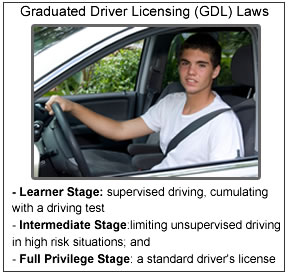Tag Archive: Graduated Driver Licensing

Teens Most Likely To Crash In Their First Month Of Solo Driving
August 16, 2012
- failure to reduce speed,
- inattention, and
- failure to yield.

Study Shows That GDL Laws Work; To An Extent
July 30, 2012
A study published in the Journal of the American Medical Association in September 2011 shows that the death rate for teen drivers under the age of 18 has fallen dramatically over the past several years. However, the good news in this study comes with a downside; the rate of fatal crashes for teen drivers over the age of 18 has risen. The reason for the increase isn’t totally certain but there are a couple of factors that some feel have led to the increase.
The Graduated Driving License (GDL) laws are working as they were designed. GDL laws place restrictions on new teen drivers that limit the number of passengers they can carry, the hours that they can drive, and their ability to use cell phones while driving. These laws were designed to limit all of the distractions that lead to so many teen deaths and, according to the researchers, they have resulted in 1,348 fewer crashes among 16 year olds.
Part of the reason for the increase in the death rate for 18 year olds is that they are now free of those restrictions and, with more passengers in the car and the ability to drive late a t night, they may be entering into driving situations that they have never experienced before and are unable to cope with.
Another reason that some experts have noted is that, with the restrictions placed on 16 year olds to complete driver training prior to getting their license, many teens are now waiting until they are 18 before getting a license. At the age of 18, there is often no requirement for any type of formal classroom or behind the wheel training. The requirement to hold a learner’s permit for a year and document up to 50 hours of supervised driving experience is also lifted for 18 year olds.
By waiting until they are 18, these drivers can often get their license in just a few weeks by passing what is generally a pretty easy driving test at the DMV. They are foregoing a lot of good training that teaches them the skills necessary to avoid collisions on the road.
If you have a teen at home that is waiting until age 18, you should insist that he or she still take all of the required courses required of 16 year olds and get at least 50 hours (ten at night) of supervised driving experience before allowing them to get their license.

Teen Death Rates Decline In States With Strong Graduated Driver License Laws
April 2, 2012
A 2006 study by the Johns Hopkins Bloomberg School of Public Health that showed Graduated Driver License Laws (GDLs) reduced teen death rates by an average of 11% has been backed up by at least two states that have shown a significant decline in their teen fatality rate after enactment of tough new GDLs.
New Jersey’s strong GDL laws will become even stronger with new GDL regulations as a result of recommendations by the Teen Driver Study Commission. The new laws or regulations are:
- No plea bargains for GDL holders (teens can’t plea bargain away points for traffic violations). Teens who accumulate 3 or more points, must attend a 4-hour MVC Probationary Driver Program and be monitored for 12 months. Any accumulation of points during the monitoring period will result in a 90 day license suspension.
- Use of a decal on the vehicle to identify drivers who hold a learner’s permit or provisional license.
- 11 PM curfew for all drivers under the age of 21 who hold a permit or provisional license.
- Limit of passengers to just one – regardless of family affiliation.
The Illinois Secretary of State introduced figures that showed a 53% drop in teen deaths between 2007 and the first 9 months of 2009. Illinois sanctions on drivers during the Initial Licensing Phase include:
- Two moving violation convictions occurring within a 24-month period will result in a minimum one-month driver’s license suspension. Suspension length is determined by the seriousness of the offenses and the driver’s prior driving history. An additional driver’s license suspension will result for each subsequent moving violation following the initial suspension.
- Any moving violation conviction that occurs within the first year of licensure will result in a six-month extension of the passenger limitation, which allows no more than one unrelated passenger under age 20.
- Suspended drivers are required to attend a remedial education course, may be retested and must pay a $70 reinstatement fee.
Parents who don’t live in a state with a strong GDL law, can impose their own strict restrictions. If you are not sure what the GDL law is in your state, visit your state’s web site or: http://www.iihs.org/iihs/topics/t/teenagers/qanda#teenagers–graduated-driver-licensing

Graduated Drivers License Laws Around the United States
June 3, 2010
Young drivers in the United Stares are subject to many different laws, regulations and procedures. Many of the rules, regulations, privileges and limitations are similar from state to state but some also differ greatly. It would be overwhelming to compare the rules and regulations young drivers face in all 50 states. It’s easier to compare the policies of a handful of states. Many states differ on age young drivers can obtain their learner’s permits and driver’s licenses; they also differ on nighttime driving and passenger restrictions. Additionally the amount of supervised driving various from state to state and the length of time a young driver needs to have a learner’s permit before they can obtain a driver’s license various as well.
Minimum Age to Obtain a Leaner’s Permit
Many states allow teenagers to get their learner’s permits once they have turned 15. The minimum age to obtain a learner’s permit in Florida, Georgia and Texas is 15. In Colorado and Illinois 15 year olds can obtain their learner’s permits if they are enrolled in drives education. In California, teenagers must be 15 years and 6 months old before they can obtain their learner’s permits. Teenagers in New York are ineligible to obtain their permits until they turn 16.
Requirements to obtain a Driver’s License
After obtaining their learner’s permits young drivers are required to possess their permits for a specific amount of time until they are able to take their road tests (assuming they have reached the minimum age to take the toad test). In California, Texas and New York young drivers are only required to have a permit for six months before they take the road test for their driver’s licenses (or restricted licenses). In Illinois a permit is required for nine months before the road test can be taken. Colorado, Florida and Georgia require young drivers to keep their permits of a minimum of 12 months.
Before young drivers are able to get their licenses they are required to log a specific be amount of time behind the wheel. Most states require that 50 hours of driving time be completed and that 10 or 15 of those hours include nighttime driving. However, Texas only requires that 20 hours of driving being completed. But, at least 10 out of the 20 hours needs to be nighttime driving. Georgia requires that drivers complete at least 40 hours of driving and that at least 6 of the hours are night time driving.
In order to obtain a driver’s license or restricted license most states require that driver’s be at least 16 and have taken driver’s education. In order to get a driver’s license without taking a driver’s education course most states require the drivers to be 17 or 18. New York State issues a junior license to 16 year olds who have held their permits for at least 6 months. If they take driver’s ed they are eligible for their senior licenses at 17, if not, they must wait until their 18. For 16 year olds in Florida, they can take the road test for their license when they turn 16 regardless if they have taken driver’s education.
Driver’s License Restrictions
Most states do not give newly licensed 16 year old boys and girl complete freedom behind the wheel. Most states have nighttime driving restrictions and many states have restrictions on the number of passengers young drivers can have in their vehicles. For example, 16 year old drivers in Florida are not permitted to drive between 11pm – 6 am and 17 year old drivers in Florida are not permitted to drive between 1 am – 5 am. Drivers in New York adhere to restrictions from 9 pm – 5 am. And drivers in Colorado and Texas adhere to nighttime driving restrictions from 12 am – 5 am.
Out of the seven states compared here, Florida is the only one that does not have a restriction in place for the number of passengers young drivers are allowed to have in their vehicles. In California, for the first 12 months young drivers are not allowed to have any non-immediate family passengers under the age of 20 in their vehicles. In Colorado and Georgia, drivers are restricted to zero passengers for the first six months they have their license and no more than one for the second six months. In Texas, Illinois and New York young drivers are not allowed to have more than one passenger under the age of 21 in the vehicle. Again, immediate family members are an exception to the rule.

Teens and Nighttime Single Vehicle Crashes
November 16, 2009
As you read the daily news, a familiar pattern begins to occur. You begin to notice the car crashes that happen at night with only one vehicle involved. Many times, these crashes involve teen drivers.
Is it your imagination? No.
Many typical characteristics of teen crashes are:
- Teens are more likely than any other age group to be involved in a single vehicle crash. Among passenger vehicle drivers’ ages 16-19 involved in fatal crashes in 2008, 49 percent were involved in single-vehicle crashes. (Insurance Institute for Highway Safety)
- Nighttime fatal crash rates for 16 year olds are nearly twice as high as daytime rates. Centers for Disease Control and Prevention (CDC)
- In 2008, 37 percent of the 15- to 20-year-old male drivers who were involved in fatal crashes were speeding at the time of the crash.
Nighttime driving not only diminishes a driver’s visibility, but also their distance and speed perception, making it harder to judge a situation and respond quickly. Speeding decreases the time and space available to react and increases the severity of any injuries. Many times teenagers react too quickly and overcorrect or lose control of the vehicle, resulting in a single-vehicle crash. Drowsy driving is also more prevalent at night, and teens are especially vulnerable to fatigue and need additional sleep during this developmental time. In addition, other drivers on the road are more likely to be less attentive, drowsy or under the influence at night.
What can be done?
Create and enforce stricter Graduated Drivers Licensing (GDL) laws that give teens the privilege of driving but limit their exposure to higher risk situations encountered, by restricting nighttime driving, teen passengers and cell phone use. Experience behind the wheel is best gained in the daytime when accompanied by an experienced adult driver and under ideal driving conditions. GDL has proved successful in reducing crashes and fatalities among teen drivers as they progress to unrestricted driving at age 18.
Teens are ready to drive and need to be given the tools to drive safely. Understand the risk factors that young teen drivers face and place limits on driving privileges until they acquire the valuable experience needed to develop those tools safely.
